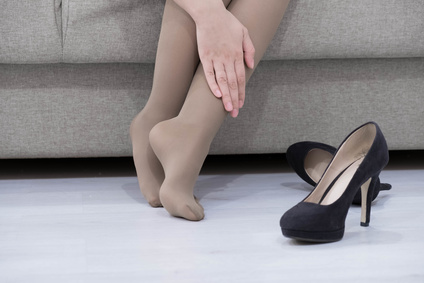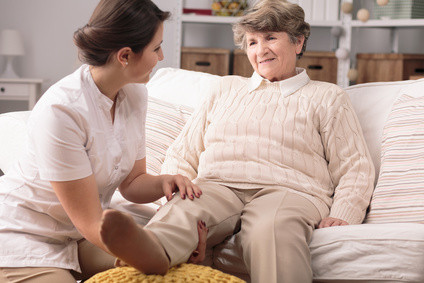Weak Leg Veins – Meaning, Causes, Symptoms, Treatment
Blood is constantly flowing through the legs, including the feet. Oxygen-rich blood reaches the legs through the arteries and the low oxygen blood is carried back to the heart through the veins. When these blood vessels (arteries and veins) are weakened or damaged then the circulation of blood through the legs are affected.
What are weak veins?
Weak leg veins are one way of describing the chronic venous insufficiency. This is a problem with blood circulation in the legs that are caused by problem veins. Just as every part of the body needs oxygen-rich blood, the low oxygen blood also has to be carried away on a constant basis. Arteries distribute the oxygen-rich blood. Veins carry it away back to the heart and lungs for re-oxygenation.
If the veins are weak then this low oxygen blood can pool in the legs and cause a host of problems. There are veins everywhere throughout the body. However, it is the leg veins that are most likely to become weakened. These veins have a more difficult task and become strained over time. This repeated strain then weakens it.

What happens when the leg veins become weak?
The heart pushes out blood with force. Blood pressure is the way we measure this force, which must not be too high nor too low. This force allows the blood to reach every part of the body via the arteries. The lower leg and feet are the farthest from the heart. By the time blood reaches the feet, the pressure is very low.
There is insufficient force to allow blood in the feet to then return to the heart. When standing, gravity further pulls down the blood and keeps it in the lower leg and feet. Force therefore has to be created in the feet and legs to push blood up the veins and to the heart. The muscles of the feet and lower legs press against the vein and push the blood up. This happens slowly.

Blood moves short distances when the muscles of the feet and legs are pressing against the vein. To prevent the blood from falling back down, the leg veins are unique in that it has large valves within it. These valves allow blood to flow in only one direction – upwards back to the torso. It closes to prevent blood from flowing backwards.
However, when these valves become weakened, the blood flow back up the legs is compromised. It travels a short distance up the leg but falls back down. The blood then pools in the legs and stretches the veins which further weakens the leg veins. Therefore blood circulation in the legs are compromised.
Causes of Weak Leg Veins
The leg has superficial and deep veins. Weakening of the superficial veins is more likely to occur but it is sometimes caused by a problem in the deep veins, like when there is a clot blocking the deep veins (deep vein thrombosis of DVT). Weakening of the superficial veins is known as varicose veins. When this is present, blood circulation in the legs are usually compromised to some extent.
As mentioned, weakened leg veins is known as chronic venous insufficiency. Chronic means that it is long term. Venous refers to the veins and the insufficiency means that the weakened veins do not allow blood flow to occur normally. Weak leg veins is a common problem, especially after the age of 50 years. There are many reasons why it occurs.
Age is a factor. The walls of the veins do naturally weaken with age but this does not mean that chronic venous insufficiency will occur in every older person. Being sedentary is another major factor. People who sit or stand for long periods are particularly prone to developing chronic venous insufficiency.
Naturally if mobility is reduced for prolonged periods for any reason, such as when a person is confined to a bed, then the risk of the veins being weakened is greater. Weakening of the leg veins is more likely to occur in obesity. Pregnancy also increases the risk. People who smoke are also more likely to develop weakened leg veins.
Signs and Symptoms
There are usually no obvious signs and symptoms in the early stages of weakened leg veins. It is only when blood flow is significantly affected by the weakening that these signs and symptoms become evident. It includes:
- Swelling of the legs and feet. This swelling tends to worsen with prolonged standing or walking.
- Aching of the legs, even with moderate periods of standing or walking.
- Tired feeling in the legs with even short periods of activity.
- Spider veins and varicose veins. New spider veins develop over time and varicose veins become larger and more prominent as the condition progresses.
- Leathery texture and look to the skin.
- Darkening of the skin also develops over time in some people.
- Itching and flaking of the skin also occurs (venous stasis dermatitis).
- Red to purple-blue spots may develop when tiny capillaries rupture in advanced cases.
- Open sores known as ulcers in severe cases (venous stasis ulcers).
Treatment of Weak Leg Veins
A diagnosis of chronic venous insufficiency must be confirmed by a doctor. An ultrasound scan, known as a vascular ultrasound or duplex ultrasound, uses sound waves to project an image of the veins. This can confirm whether the vein is weakened and blood flow is hampered. There are several treatment options depending on the severity of the vein weakening.
Supportive measures include the use of compression stockings, regular exercise and elevating the legs as often as possible. Non-surgical treatment helps to either shrink or seal off the problem vein. These procedures are known as sclerotherapy and endovenous thermal ablation, respectively.
Surgical procedures like ligation and stripping, and microincision phlebectomy may be performed to remove the problem veins. Another surgical option is a vein bypass. Here a normal vein is taken from elsewhere in the body and used to redirect the blood flow around the problem vein. Preventative measures like regular exercise must be taken to prevent recurrence of weak leg veins.
Reference:
- Chronic venous insufficiency. Cleveland Clinic






